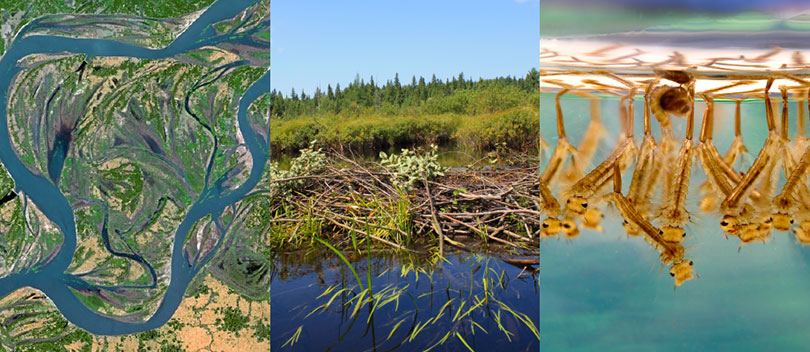
Messy Rivers are Healthy Rivers
Dr. Ellen Wohl provoked the audience to give thought to how we evaluate river health in her keynote address to the Riverflow 2016 Conference in St. Louis Missouri. Here is a link to her talk as given at the Sagan National Colloquium
Mindfulness of one’s own motivations and openness to a broader perspective is a good starting place for this discussion.
Whereas a concrete-lined drainage ditch is highly functional in one world-view, a poorly drained swamp can be highly functional in a different world-view. In order to understand rivers we need to be self-aware of our place in the natural order of things.
A collective effect of both intentional and unplanned modifications to river systems since colonization of North America has been a systematic reduction in physical complexity. Hundreds of years of development of dams, diversions, and river training have compounded the effects from the loss of old growth forests and a decimation of beavers (from an estimated population of 125 million to 200 million to the current population of 6 million to 12 million).
Modern rivers are relatively straight, relatively free of channel-spanning log jams, relatively free of beaver dams, and relatively single threaded.
In other words, the influence of man has been the simplification of rivers. Absent man, rivers are inherently messy.
Messy rivers are physically complex, which has several biodiversity implications:
- Habitat abundance and diversity
- Resistance and resilience to change (i.e. habitat persistence)
- Retention of water, sediments, and nutrients (i.e. habitat enrichment)
- Connectivity – surface to sub-surface, channel to floodplain, upstream to downstream (i.e. habitat interactivity)
As an example consider the sequence of effects of removal of beavers from a sub-alpine stream. While beavers are present and maintaining their dams:
- Ample hyporheic exchange flow enriches, and cools, surface water quality
- Sediments, organic matter, and nutrients are stored in, rather than flushed from, the system
- A persistent high water table favors dense willow growth
- The willows reduce the velocity of over-bank flooding and favor the multi-threading of channel structures
However, when beavers are removed, their dams disappear and:
- The water table drops, drying out the floodplain soil
- Willows are out-competed by more drought-tolerant and grazing-resistant species
- The floodplain becomes less resistant to fire disturbance
- The floodplain loses its resilience to flooding – a single threaded channel scours and becomes more deeply incised, further lowering the water table in between flood events, while sediments, nutrients, and organic material are flushed from the system
If one values biodiversity, resistance, resilience, water quality, and water conservation then messy rivers seem like a good thing.
In the face of threats to our watersheds from climate change this seems like a really good time to be investing in these values. Left to their own, beavers will even do the needed work for us and at a far cheaper rate than most river engineers would bill.
Some readers may wonder how I can reconcile this post with my opinions expressed in Stream Gaugers vs. Beavers. It is about mindfulness of one’s own motivations and openness to broader perspectives.
As much as messy rivers are a good idea, we are unlikely to stop messing with the messiness of rivers anytime soon. As one participant noted in a question to Dr. Wohl, mosquitoes also like messy rivers and mosquito habitat enhancement is not going to be politically viable in many jurisdictions anytime soon.
Decisions about river systems are made one funding opportunity at a time.
Proposals that are messy with competing objectives have little chance of funding. A long history of watershed management, addressing one tidy objective at a time, has got us to where we are now. Like an addicted smoker, we may understand that what we are doing to our rivers is unhealthy, but I am not sure we can quit the habit.


